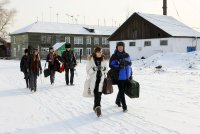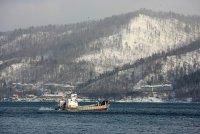We left our train, our cosy home, for an excursion along the shores of lake Baikal. We’re met by Denis and Arkady, local representatives of Russian Railways and our guide Marina. Our transport is a neat, new single coach train. It crawls out of Sludyanka station and soon we’re caught between the lake on our right and cliffs the rising on our left as we head north.
This was the original route of the Trans-Siberian but now its only a single track railway used for tourist excursions and the very occasional local train connecting a series of tiny villages to civilisation.
The train stops and we are taken for a stroll through a fine stone lined tunnel and over a bridge. Marina explains that these were built by Italian masons and have withstood the regular earthquakes that shake this area as well as the occasional rockslide.
We pass a tiny village housing more dogs than people. There is no sign of the eight residents but three dogs run out to bark at us a we walk by on the side of the railway. Looking down to the lakeside there is the most spectacularly beautiful sight. All the shrubs and trees on the shoreside are encased in exquisite ice chandeliers.
As the waves roll in against the shore, water is splashed up and it freezes as it hits the deep-frozen vegetation. Ice forms on ice until you have bursting showers of icicles festooning bushes and trees. As the sun sets the golden red reflection tracks across the lake and ignites a glow in these ice-chandeliers.
The night is spent in a luxurious wooden lodge and after a banya where we are given very fetching bath-caps, a superb supper of four different types of fish. I’m not usually very bothered by fish but the 50 cm long cig that formed the highpoint of the meal was delicious. Apparently it’s a relative of salmon, but spends its whole life-cycle in fresh water.
In the morning it was a short trip to Port Baikal. Before 1904 when the Trans-Siberian was completed, people used to disembark from the train and take a ferry across the lake from this harbour. The largest ferry at the time, the Baikal, was made in Newcastle in England and transported in pieces to Lake Baikal where it was assembled under the supervision of a five engineers from Newcastle.
We were shown around a small museum and the guide told us that the chief engineer stayed on after his four colleagues departed to supervise some finishing touches, and then when he was happy the job was completed some nine months after re-assembly had started, learned he was stranded because nobody had bought him a return ticket. I was not able to find out his name or what happened to him next. If you know, please tell me!
Although the Baikal could fit a whole train on the tracks built across its deck it had trouble breaking throughout the ice in winter and it and its sister ship, the Angara, were stuck fast when the Japanese attacked East Russia in 1904. As men and munitions built up at the Port bail bottleneck, Prince Khilkov ordered that a line be built across the ice. Extra wide sleepers spread the load but the first train plunged into the depths. The track had crossed warm springs that melted the ice above. After that, men walked and munitions were dragged the 40 km across to the other side.
Our time at Baikal ended with a boat-ride across the mouth of the Angara. This great river is the only river leaving Lake Baikal and drains such a huge volume of water that it never freezes, even when the lake behind it is two metres deep in ice. Later as we travelled down the side of the Angara to Irkutsk and the next stage of our trip on the Trans-Siberian railway I marvelled at the great width of the river as at times it broadened into a fine imitation of its parent.

